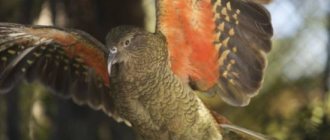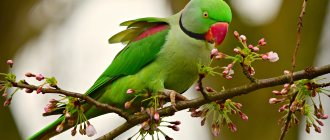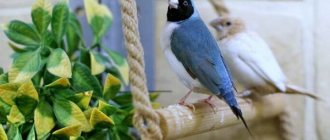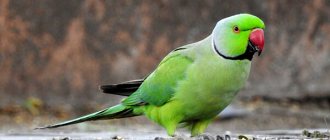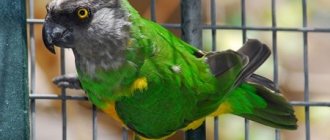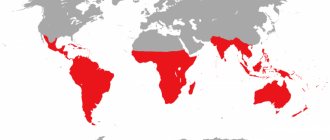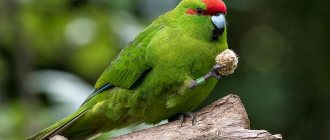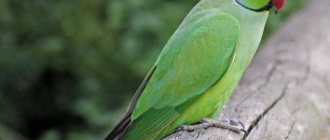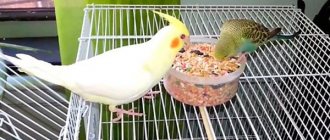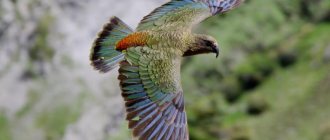| Squad | Psittaci, Psittaciformes = Parrots, parrots |
| Family | Psittacidae = Parrots, Psittacidae |
| Subfamily | Psittacinae = True parrots |
| Genus | Ara = Ares |
| View | Ara ararauna = Blue-yellow macaw |
Appearance
| Name and classification | Blue-and-yellow macaw Ara ararauna |
| Photo | |
| Length | 0.76—0.95 m |
| Wings | The span is from 1.04 to 1.14 m |
| Tail | 0.52 m |
| Adult weight | 0.9-1.3 kg |
| Color | A combination of blue (back, wings), blue (back, wings, tail), yellow (neck, belly, wings, tail), green (head), black (throat) colors. |
| Beak | Strong, curved to the bottom, black in color. |
| Eyes | Straw-yellow (in young animals – brown with a gray tint). |
| Paws | Brown-black |
| Sex differences | Females, unlike males, have a wider head and a narrower beak. |
| Peculiarities | Unfeathered cheeks and areas around the eyes with black stripes of small feathers. |
| Conservation status | The species is under the control of the CITES convention (Appendix II) |
Color options
In general, the colors of birds do not affect their character. Budgerigars can be divided into 2 groups based on color. The first of them includes individuals with normal wavy, the second - variegated ones, such as albinos, harlequins, etc. As for blue birds, they belong to the first group.
Primary colors have their own gradation, for example, blue parrots can be classified by shade as follows.
- The classic blue parrot is a bird with a blue belly, back and chest. The predominant color on the muzzle is white, the cheeks have a purple tint, the head has black feathers, and the tail has blue feathers. The waves are painted black.
- The second group is blue and gray. The main difference from representatives of the classic blue species is the predominance of gray or deep blue tone. Sometimes blue-gray birds can be seen.
- And finally, purple parrots. This shade predominates on the cheeks, back and stomach. The tail feathers are blue-green. The muzzle is white.
Where do they live?
You can meet the Blue-and-yellow parrot in the following Latin American countries:
- Panama
- Paraguay
- Bolivia
- Ecuador
- Guyana
- Peru
- Suriname.
Currently, wild populations of these birds have noticeably decreased in Brazil, Venezuela, and Colombia.
In Trinidad, this species has completely disappeared.
INTERESTING FACTS, INFORMATION…
- The feeding area of the blue-and-yellow macaw is often located at a distance of 25 km from the roosting site.
- On the island of Cuba by the end of the 19th century. there lived a tricolor macaw. This bird was bright red in color, the top of its head was yellowish-red, and its neck was green.
- Blue and yellow macaws are very noisy birds.
- The order Parrots includes over 300 species. All macaws are inhabitants of the American rainforests.
- The largest is the hyacinth macaw (Andorhynchus hyacinthinus), whose length from head to tip of the tail is about 98 cm. The smallest is Spix's macaw (Cyanopsitta spixii), or the small blue macaw, which is 50 cm long.
Lifestyle and nutrition in the wild
Ararauna are found in pairs or small flocks. Although sometimes birds can gather even in large groups - up to 100 individuals. They live in tropical forests near rivers, as well as in swampy areas and mountain valleys. They become strongly attached to their place of residence.
After a night's rest, they fly out in the morning to look for food. They can fly up to 30 kilometers in a day. At night and during the day, during the heat, they hide in the crowns of tall trees.
They often fly to river shallows, where they ingest river silt mixed with various minerals. According to ornithologists, eating river clay helps birds neutralize toxins that enter the bird's stomach from unripe fruits eaten.
The natural diet of parrots includes:
- seeds (khura),
- nuts (Brazil, bottle, tucuma, Mauritius, nuts, buriti),
- fruits (mango),
- tree bark,
- berries,
- flowers,
- sometimes - insects, larvae, small lizards.
Intelligence
The macaw is not only a beautiful but also a very smart parrot. By nature, he inherited remarkable intelligence, which helps the bird survive in natural conditions and adapt to life in captivity. In a flock, parrots take care of each other, give signals of danger, and search for food together. At the right moment they can become quiet in order to avoid an attack.
When kept at home, the macaw parrot behaves in any situation as if it were the master of the situation. He knows how to get out of difficult conditions and does not allow himself to be commanded. With proper upbringing, it is easy to come to an agreement with a macaw. If you start taming and training in a timely manner, you can raise an excellent trickster, ready to follow commands and solve logical problems.
Macaws have the ability to speak. This is not the kind of meaningful conversation that a gray parrot can conduct, but quite distinct phrases and words. Some individuals pronounce memorized words to the point, and it seems that they use them according to the meaning of the conversation. Birds can “sing” (transmit a melody with their voice) and dance to the beat of the music. This confirms that their level of intelligence is quite high.
Lifespan
Ornithologists say the average lifespan in the wild for blue-and-yellow macaws is about 40 years, although scientists believe only a very small percentage of birds of this species survive to that age. Among the reasons that significantly shorten the life of birds are unfavorable environmental conditions, deforestation, changes in climatic conditions, and poaching.
As for birds in captivity, the official record holder, who managed to reach 43 years of age, is the Blue and Yellow Macaw, who lived in one of the Danish zoos. Most tamed Araruans live in captivity from 25 to 35 years. Their life expectancy is negatively affected by improper care and nutrition.
Habitat
The macaw parrot lives in South America: the northern and central parts of the continent, in the Amazon River basin, on the west coast and in the foothills of the Andes. Each species has its own habitat: some parrots live in the tropics, others in humid equatorial forests, and others in mountainous areas. Some representatives of the genus Ara prefer dry steppe areas or cool ocean coasts.
Reproduction (in the wild and in captivity)
| Blue-and-yellow Macaws become sexually mature when they reach 4 years of age. They are characterized by monogamy (one partner for life). But if one of the partners loses, the other can easily find a replacement. The mating season begins at the beginning of winter and lasts until the beginning of spring. Nests are built on branches or in hollows of tall trees. Offspring do not appear every year. After a short period of courtship, the female begins to lay a clutch (from 2 to 5 eggs). The incubation period is one month. All this time, the male feeds his “beloved” and protects the future replenishment. Both parents are involved in feeding the hatched offspring. The chicks begin to leave the nest from the third month, but finally move on to independent life only at 6 months of age. | |
| Araruans reproduce well in captivity if you create comfortable living conditions for them (large enclosure, nesting box, proper diet, minimum contact with humans). In captivity, the mating season begins in April. It is on these days that contact with birds should be reduced as much as possible, because birds can show aggression, even towards their owner. A clutch rarely contains more than 3 eggs, most of which are often unfertilized. As in the natural environment, the female does the incubation, and both parents feed the offspring. Until the age of 3 months, it is better to try not to disturb the parrot family, so as not to cause stress or aggression towards the young. Chicks begin to be removed from their parents at 4 months of age. |
Video my parrots blue-yellow macaw Pipka and green-winged Monya
Purchase
Connoisseurs of luxurious exoticism strive with all their might to get a blue-and-yellow macaw parrot. It is recommended to take 4-5 month old chicks from the nursery, ringed. In order not to be deceived, you need to know: the country where the nursery is located and the date of birth of the chick are engraved on the non-removable ring. After all, the price of large ornamental birds is simply sky-high: from 150,000 rubles for a tame young bird.
Features of keeping the Blue-and-yellow macaw at home
Araruan has been tamed since ancient times until today. In addition to their extraordinary beauty, parrots amaze with their high intelligence and ability to speak. But at the same time, they require special conditions of maintenance and constant attention from the owner.
Considering that the Blue-and-Yellow Macaw is a large bird, it requires a huge cage (from 0.6x0.9 m) or an aviary (at least 3x2x3 m) with horizontal metal rods 0.5-1 cm thick. This is the space that will allow the bird move around without difficulty. They equip the bird's home with a retractable tray and a lock with a special 2-turn mechanism (so that the parrot cannot open it). Mandatory equipment - feeders, drinking bowls, bathtub, toys, perches.
The Araruan parrot is a lover of gnawing and snacking on everything (even steel wire) that comes in its way. Therefore, it is better for him to initially equip a large enclosure so that there is no need to let him out for a walk. This will protect the owner from property damage.
The diet of the blue-yellow beauty should include:
- Factory-made grain concentrates for large parrots or grain (wheat, oats, millet, corn, legumes) - 60% of the total food.
- Fruit: apricots
- pears
- apples
- grape
- citruses
- bananas
- peaches.
Poisonous foods for parrots:
- Cherry pits and apricot.
- Salt.
- Sugar, chocolate, candy.
- Coffee Tea.
- Parsley.
Temperament and behavior of Blue-and-yellow macaws
Blue and Yellow Macaws are active and sociable. They are also considered the most “diligent” students - they willingly complete tasks, repeat various tricks, and quickly learn spoken human speech (able to memorize up to 30 phrases). If we do not take into account the aggression of the mating season, then it is these parrots that are distinguished by the greatest sociability and loyalty towards humans. They quickly become attached to their owner and enjoy spending time with him.
In order for a bird to treat all family members equally, it must be socialized (introduced to the human community) from an early age.
One of the unpleasant moments is loudness. Birds like to make noise early in the morning and in the evening. This behavior is quite normal for this species. The only thing that can distract your feathered pets from their daily “serenades” is a variety of toys, frequent communication with them, and training sessions.
Video Macaw parrot at home
Free lifestyle
There is a lot in common in the behavior and lifestyle of different macaw species. They are sociable and peaceful, and do not conflict over food or individuals of the other sex. There is no hierarchy in a flock of macaws, which means there is no leader who subjugates the rest of the parrots. But young animals always “give way” to adults. By the way, the “engagement” of young macaws occurs long before their first nesting. The male and female spend many years in an inseparable union, like affectionate and devoted friends. They don’t have “divorces.” Only an accident can separate the partners, and then the remaining bird immediately begins the search for a new “other half.”
With the onset of the nesting period, the couple chooses an old, tall and very wide tree with a hollow or crack in the trunk. If necessary, parrots enlarge the entrance to the future nest using their beak. Each family is very attached to its site, preferring to nest in the same hollow from year to year (at least if no one disturbs the birds there). Sometimes macaws dig burrows in clayey river cliffs.
Like other consumers of seeds and fruits, these parrots, with the exception of nesting time, roam to the places where their favorite food ripens. It happens that a flock leaves the forest and makes a devastating raid on agricultural plantations. Macaws do not fly very fast, smoothly flapping their long wings. It is a mistake to consider them sluggish and clumsy, although they do not have the liveliness and cheerfulness characteristic of other local parrots. On the branches, these tall, heavy-set birds behave cautiously and calmly. It is difficult to observe the life of macaws in nature, since the dense crowns of trees camouflage them well. Oddly enough, the bright plumage plays the role of an “invisibility cap”. The silhouette of a multi-colored bird seems to be broken into fragments that are incomprehensible and barely noticeable to humans and predators; green species simply blend in with the foliage. Parrots often sit at the very tops of the crowns and behave very quietly if they do not see anything suspicious. Several dozen macaws of different species can feast on an abundantly fruiting tree. There is enough food for everyone, and the flock does not try to protect the tree from other flocks. But during the day and night rest, each group is arranged separately.
The main enemies of macaws are the South American harpy (a large bird of prey from the hawk family) and people. Due to economic activity, humid tropical high-stem forests, outside of which the macaw is doomed to extinction, are disappearing at an alarming rate.

